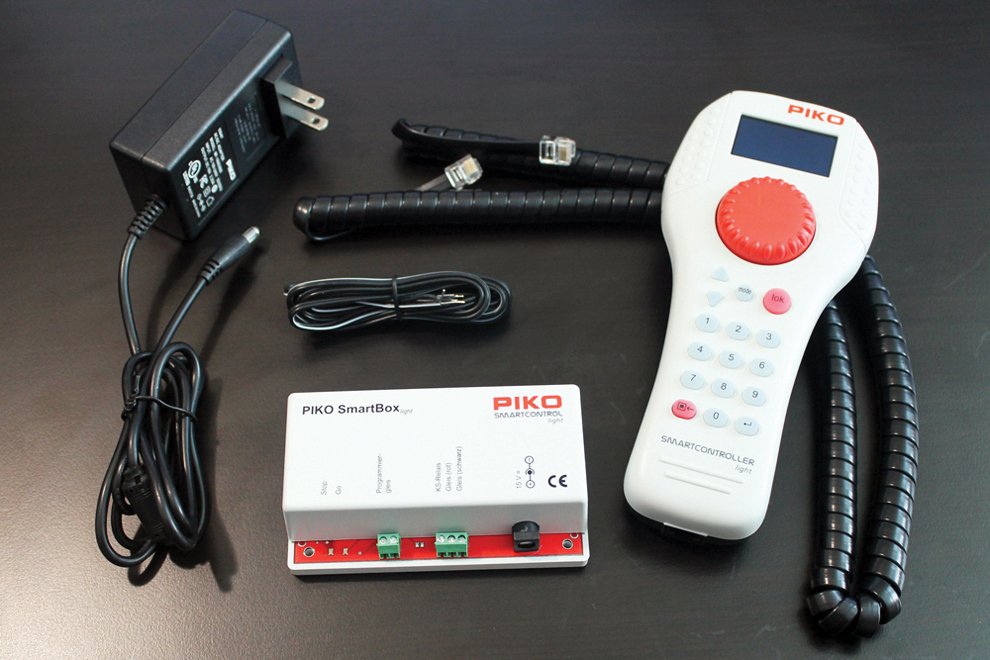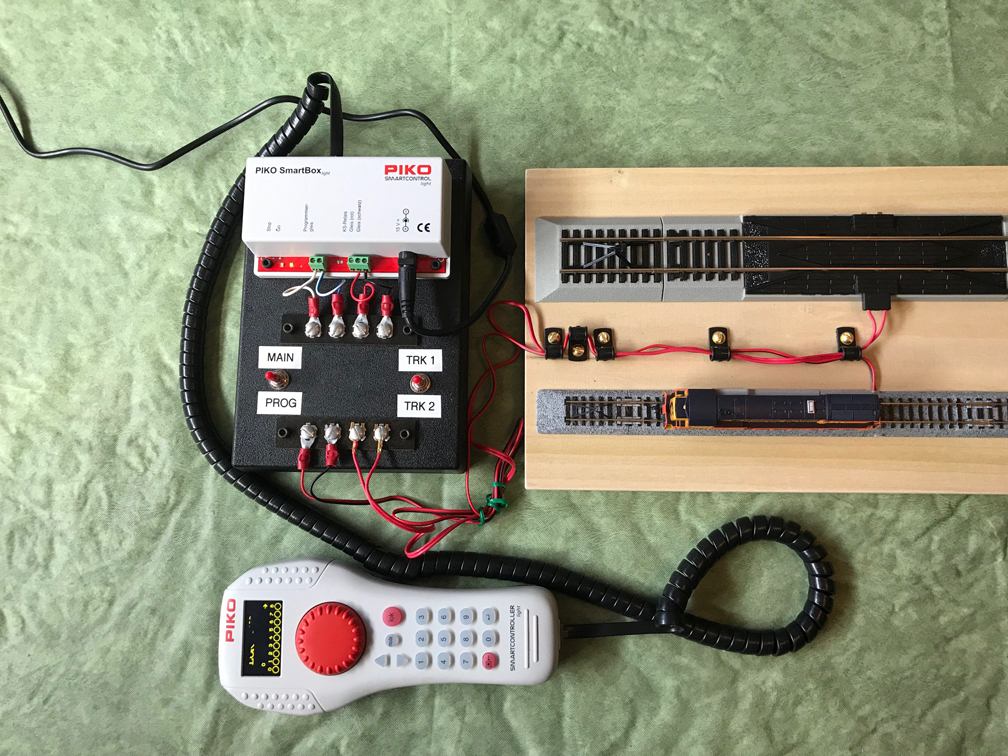All about the community of model railroading and rail enthusiasm

By TOM MARSH/Cowcatcher Magazine
Model railroaders seeking an affordable, easy-to-use DCC system for smaller layouts should consider the PIKO SmartControlâ light Basic Set. The set is designed for use with HO, N and TT layouts and has advanced features not seen in other entry-level DCC systems.
At an MSRP of $194.99, PIKO has positioned the SmartControl light Basic Set as a less expensive alternative to its full-featured $494.99 SmartControl model railroad DCC system.
Setting up the SmartControl light on a small layout is plug-and-play simple. It takes longer to remove the system from the box than it does to get a train running.
Just connect the layout track to the SmartBox light track power port, plug in the throttle and connect the AC/DC adapter. Selecting a decoder-equipped locomotive entails pressing the LOK (German for locomotive) button on the SmartController light, entering the address via the keypad and pressing the LOK button again. Then turn the throttle knob to go.
PIKO’s SmartConrol light Basic Set includes one handheld throttle, a control module, a coiled cable for connecting the SmartController light to the SmartBox light, an AC/DC adapter, a length of multi-strand two-conductor wire for track power, and a glossy, four-color multilingual instruction manual. The SmartControl light Basic Set can program and control DCC locomotives, turnouts and other DCC accessories.

The system allows individual and simultaneous control of up to 20 locomotives with 14, 28 or 128 speed steps and can be expanded to support additional throttles.
The SmartControl light can store data for up to 9,999 locomotives and 2,048 DCC-compatible accessories such as turnouts and signals. In addition, the system can be set up for control of 16 track routes, with up to 10 switching sequences per route.
Provision is made for controlling reverse loop polarity with the use of a third-party reversing relay. The SmartBox light incorporates a Digitrax-compatible LocoNetâ port, allowing use of a wide range of LocoNet-compatible devices.
The SmartController light is lightweight and comfortable to hold in either hand. Locomotive speed and direction are controlled by a large red rotary throttle. The digital display is bright and sharp, and buttons and the throttle knob have a good tactile feel.
As configured out of the box, power to the display shuts off if the throttle is inactive for five minutes. The display shut-off timing can be adjusted.
In locomotive mode, horn, bell, whistle and other decoder functions are controlled via the keypad. Function controls are presented in three blocks (F1-F8; F9-F16; F17-F24) selected by the up/down arrow keys. The selected function block and the status of each function are shown in the display. The 0 key controls the headlight in all three function blocks.
After a few minutes studying the manual, setting addresses and configuration variables (CVs) is straightforward. The SmartBoxâ light module has a dedicated output port for a programming track, which is required for setting locomotive decoder addresses.
A temporary programming track can be set up in less than a minute with a few pieces of sectional track and a length of two-conductor wire. The programming track should not be connected electrically to the main layout track during programming activities.
CVs can be programmed on the programming track or the main track. When the SmartController light is used in Program Mode with a locomotive on the programming track, power to the layout track is shut down and the SmartController light sends signals only to the programming track. When programming CVs on the main, the SmartController light sends signals only to the selected locomotive.
The system has limited consisting capabilities. Advanced Consisting, where locomotives with different addresses are controlled as one multiple-unit consist, is limited to two locomotives, but Basic Consisting, where all locomotives in a multiple-unit lash-up are programmed with the same decoder address, allows control of as many locomotives as the system will support. This will vary depending on scale and the type of decoders in use. The system’s maximum output is 2 amps.
Another minor limitation is the wired throttle, which could be inconvenient for some layout configurations. However, given that the SmartBox light can link to LocoNet devices, resourceful modelers needing more flexibility will be able to set up multiple ports around the layout or even configure a wireless solution for smartphone control.
The manual notes that while in operation the throttle will remember its current settings if unplugged from one location and moved to another.PIKO’s SmartControl light Basic Set delivers what is promised: an easy-to-use, economical, feature-packed starter DCC system suited for small to medium layouts.
PIKO America, best known in the U.S. for its range of G-scale locomotives and cars, is the North American distributor for the SmartControl light Basic Set. The system was designed and engineered by PIKO of Sonneberg, Germany, and is manufactured in China. For more information, visit www.piko-america.com. The detailed SmartControl light manual can be downloaded from the Special Links section at www.piko-shop.de.
See other product reviews.